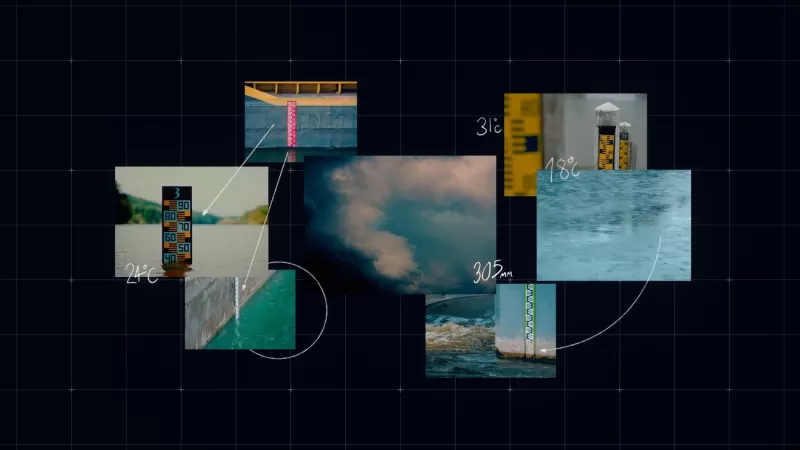AI-Enhanced Flood Forecasting: Partner Support Expanded

Every year, devastating floods wreak havoc, leading to tragic losses, mass displacement, and huge financial damage. To support governments, NGOs, global organizations, and vulnerable communities in taking proactive measures, our team at Google Research has been working on cutting-edge AI solutions to deliver precise flood data and enhance climate resilience. Our groundbreaking global flood forecasting models, published in *Nature*, now offer near real-time information to assist communities and organizations worldwide.
In line with our goal to make flood forecasting information accessible globally through AI, we're excited to announce several key expansions:
- We're extending our AI-powered riverine flood forecasting model to cover 100 countries, up from 80, reaching areas where 700 million people live, a jump from 460 million.
- We've developed an enhanced flood forecasting model that matches the accuracy of our previous model at a five-day lead time, but now at seven days.
- We're making our model forecasts accessible to researchers and partners through an upcoming API and our Google Runoff Reanalysis & Reforecast (GRRR) dataset.
- We're expanding coverage for researchers and experts by introducing "virtual gauges" for data-scarce locations via an upcoming API, the GRRR dataset, and a new expert data layer on Flood Hub, featuring nearly 250,000 forecast points across 150 countries.
- We're also releasing historical datasets from our flood forecasting model to aid researchers in understanding and mitigating the impact of devastating floods.
These expansions will bring vital riverine flood information to millions of people globally and provide researchers and partners with more comprehensive data.
Expanding Flood Forecasting Coverage to Reach More Countries and More People
By expanding our AI-powered riverine flood forecasting model to over 100 countries, we're now able to serve 700 million people worldwide, a significant increase from the previous 460 million. This expansion is fueled by recent research breakthroughs that have boosted our model's accuracy. We've incorporated more labeled data, tripled the number of training locations, introduced a new model architecture for increased robustness, and integrated a new weather forecasting model into our flood predictions. You can dive deeper into these developments on our Research blog.
This means more communities will have timely access to flood information, improving preparedness and response efforts for millions worldwide, accessible through Google Search, Google Maps, and Google Flood Hub.
Making Flood Forecasting Data Available for Experts and Researchers in More Ways and More Places
We're now sharing our advanced flood forecasting model forecasts, which boast improved accuracy, reliability, and broader coverage, with researchers and partners via GRRR and an upcoming API.
Our new API pilot program, developed with leading organizations, is open for signups. This API will enable researchers and practitioners to access our hydrologic forecasts and anticipated flood status, even in data-limited regions, to accelerate flood research and response.
While our global hydrologic model can predict discharge anywhere on Earth, Flood Hub currently only shows forecasts at points with gauges for verification using historical data from reliable sensors. However, many parts of the world lack these sensors. To address this, we're adding a new data layer to Flood Hub with 250,000 forecast points from our Flood Forecasting model using "virtual gauges." This will provide additional flood forecasting data to experts and researchers in over 150 countries, including those without physical gauges, enhancing data availability for previously underserved areas.
Our flood forecasting model now covers over 100 countries (sample of countries pictured left) and includes "virtual gauges" for experts and researchers in more than 150 countries (sample of countries pictured right).
We're also making historical outputs of our global flood forecasting model publicly available through GRRR. This dataset, which dates back to 1981, shows historical flood forecasts and alerts on a global scale, allowing researchers to analyze our model's past performance. We believe this data will help researchers worldwide understand the impact of flooding on communities and potentially lessen the effects of devastating floods.
Thanks to the latest enhancements to our model and the inclusion of richer data, we can now share significantly more forecasts with researchers and partners, particularly in data-scarce regions. The new model's accuracy at a seven-day lead time is as good as the previous model's at five days, with reliability matching state-of-the-art global flooding nowcasts. We'll keep refining our forecasts and increasing the accessibility of flood forecasting information, collaborating closely with research and expert communities.
Using AI for Climate Action Across the Globe
Our flood forecasting models now provide actionable information directly to people on the ground, communities, researchers, experts, governments, and aid organizations, helping them take anticipatory action to protect vulnerable populations.
For instance, during the devastating floods in Rio Grande do Sul, Brazil, last May, our Google Research team worked with the Geological Service of Brazil (SGB), our partner since 2022, to add over 200 new monitoring locations to Flood Hub. This data was crucial for public authorities and residents in the affected areas to develop crisis response plans and make informed decisions.
In addition to our collaboration with Brazilian local authorities, our flood forecasts were utilized by aid organizations like World Vision Brazil and its local partners to predict flood-affected regions and swiftly distribute essential aid, including drinking water, food baskets, and bedding kits, within just two days.
Earlier this year, we highlighted how four humanitarian organizations across Africa and India leveraged our flood forecasting technology to aid communities. As we continue to expand our research, refine our forecasts, and make flood forecasting information more accessible, Google Research is committed to addressing the impacts of climate crises using AI and providing actionable safety information for crisis response, in alignment with the UN's Early Warnings for All initiative. This effort ensures that critical information reaches governments, international organizations, and NGOs, empowering them to protect affected communities.
Related article
 Midjourney Unveils Cutting-Edge AI Video Generator for Creative Content
Midjourney's AI Video Generation BreakthroughMidjourney has unveiled its inaugural AI video generation tool, marking a significant expansion beyond its renowned image creation capabilities. The initial release enables users to transform both uploaded
Midjourney Unveils Cutting-Edge AI Video Generator for Creative Content
Midjourney's AI Video Generation BreakthroughMidjourney has unveiled its inaugural AI video generation tool, marking a significant expansion beyond its renowned image creation capabilities. The initial release enables users to transform both uploaded
 Trump Prioritizes AI Growth Over Regulation in Race to Outpace China
The Trump administration unveiled its landmark AI Action Plan on Wednesday, marking a decisive break from the Biden administration's risk-averse AI policies. The ambitious blueprint prioritizes aggressive infrastructure development, sweeping regulato
Trump Prioritizes AI Growth Over Regulation in Race to Outpace China
The Trump administration unveiled its landmark AI Action Plan on Wednesday, marking a decisive break from the Biden administration's risk-averse AI policies. The ambitious blueprint prioritizes aggressive infrastructure development, sweeping regulato
 YouTube Integrates Veo 3 AI Video Tool Directly Into Shorts Platform
YouTube Shorts to Feature Veo 3 AI Video Model This SummerYouTube CEO Neal Mohan revealed during his Cannes Lions keynote that the platform's cutting-edge Veo 3 AI video generation technology will debut on YouTube Shorts later this summer. This follo
Comments (17)
0/200
YouTube Integrates Veo 3 AI Video Tool Directly Into Shorts Platform
YouTube Shorts to Feature Veo 3 AI Video Model This SummerYouTube CEO Neal Mohan revealed during his Cannes Lions keynote that the platform's cutting-edge Veo 3 AI video generation technology will debut on YouTube Shorts later this summer. This follo
Comments (17)
0/200
![BenGarcía]() BenGarcía
BenGarcía
 August 6, 2025 at 9:00:59 AM EDT
August 6, 2025 at 9:00:59 AM EDT
This AI flood forecasting sounds like a game-changer! 😮 Curious how fast it can predict floods compared to old methods. Could save so many lives!


 0
0
![FrankWilliams]() FrankWilliams
FrankWilliams
 July 23, 2025 at 12:59:29 AM EDT
July 23, 2025 at 12:59:29 AM EDT
This AI flood forecasting sounds like a game-changer! Curious how accurate it is compared to traditional methods. 🤔 Hope it reaches more communities soon!


 0
0
![JustinJackson]() JustinJackson
JustinJackson
 April 24, 2025 at 10:03:16 AM EDT
April 24, 2025 at 10:03:16 AM EDT
A previsão de enchentes aprimorada por IA é um salva-vidas! As previsões são tão precisas que nos ajudam a nos preparar com antecedência. A única coisa é que poderia ser um pouco mais amigável para quem não é técnico. Ainda assim, essencial para o gerenciamento de desastres! 👍


 0
0
![JuanAllen]() JuanAllen
JuanAllen
 April 22, 2025 at 1:22:52 AM EDT
April 22, 2025 at 1:22:52 AM EDT
AI-Enhanced Flood Forecasting is a lifesaver! It's amazing how it helps predict floods so communities can prepare. Only wish it was a bit more user-friendly for non-tech folks. Still, a great tool! 👍


 0
0
![CarlLopez]() CarlLopez
CarlLopez
 April 20, 2025 at 7:45:16 PM EDT
April 20, 2025 at 7:45:16 PM EDT
AI-Enhanced Flood Forecasting is a lifesaver! It's amazing how accurate the predictions are, helping us prepare in advance. The only thing is, it could be a bit more user-friendly for non-tech folks. Still, a must-have for disaster management! 👍


 0
0
![AnthonyJohnson]() AnthonyJohnson
AnthonyJohnson
 April 16, 2025 at 12:04:06 PM EDT
April 16, 2025 at 12:04:06 PM EDT
¡La predicción de inundaciones mejorada por IA es un salvavidas! Es increíble cómo ayuda a predecir inundaciones para que las comunidades puedan prepararse. Solo desearía que fuera un poco más amigable para los no técnicos. Aún así, ¡una gran herramienta! 👍


 0
0

Every year, devastating floods wreak havoc, leading to tragic losses, mass displacement, and huge financial damage. To support governments, NGOs, global organizations, and vulnerable communities in taking proactive measures, our team at Google Research has been working on cutting-edge AI solutions to deliver precise flood data and enhance climate resilience. Our groundbreaking global flood forecasting models, published in *Nature*, now offer near real-time information to assist communities and organizations worldwide.
In line with our goal to make flood forecasting information accessible globally through AI, we're excited to announce several key expansions:
- We're extending our AI-powered riverine flood forecasting model to cover 100 countries, up from 80, reaching areas where 700 million people live, a jump from 460 million.
- We've developed an enhanced flood forecasting model that matches the accuracy of our previous model at a five-day lead time, but now at seven days.
- We're making our model forecasts accessible to researchers and partners through an upcoming API and our Google Runoff Reanalysis & Reforecast (GRRR) dataset.
- We're expanding coverage for researchers and experts by introducing "virtual gauges" for data-scarce locations via an upcoming API, the GRRR dataset, and a new expert data layer on Flood Hub, featuring nearly 250,000 forecast points across 150 countries.
- We're also releasing historical datasets from our flood forecasting model to aid researchers in understanding and mitigating the impact of devastating floods.
These expansions will bring vital riverine flood information to millions of people globally and provide researchers and partners with more comprehensive data.
Expanding Flood Forecasting Coverage to Reach More Countries and More People
By expanding our AI-powered riverine flood forecasting model to over 100 countries, we're now able to serve 700 million people worldwide, a significant increase from the previous 460 million. This expansion is fueled by recent research breakthroughs that have boosted our model's accuracy. We've incorporated more labeled data, tripled the number of training locations, introduced a new model architecture for increased robustness, and integrated a new weather forecasting model into our flood predictions. You can dive deeper into these developments on our Research blog.
This means more communities will have timely access to flood information, improving preparedness and response efforts for millions worldwide, accessible through Google Search, Google Maps, and Google Flood Hub.
Making Flood Forecasting Data Available for Experts and Researchers in More Ways and More Places
We're now sharing our advanced flood forecasting model forecasts, which boast improved accuracy, reliability, and broader coverage, with researchers and partners via GRRR and an upcoming API.
Our new API pilot program, developed with leading organizations, is open for signups. This API will enable researchers and practitioners to access our hydrologic forecasts and anticipated flood status, even in data-limited regions, to accelerate flood research and response.
While our global hydrologic model can predict discharge anywhere on Earth, Flood Hub currently only shows forecasts at points with gauges for verification using historical data from reliable sensors. However, many parts of the world lack these sensors. To address this, we're adding a new data layer to Flood Hub with 250,000 forecast points from our Flood Forecasting model using "virtual gauges." This will provide additional flood forecasting data to experts and researchers in over 150 countries, including those without physical gauges, enhancing data availability for previously underserved areas.
Thanks to the latest enhancements to our model and the inclusion of richer data, we can now share significantly more forecasts with researchers and partners, particularly in data-scarce regions. The new model's accuracy at a seven-day lead time is as good as the previous model's at five days, with reliability matching state-of-the-art global flooding nowcasts. We'll keep refining our forecasts and increasing the accessibility of flood forecasting information, collaborating closely with research and expert communities.
Using AI for Climate Action Across the Globe
Our flood forecasting models now provide actionable information directly to people on the ground, communities, researchers, experts, governments, and aid organizations, helping them take anticipatory action to protect vulnerable populations.
For instance, during the devastating floods in Rio Grande do Sul, Brazil, last May, our Google Research team worked with the Geological Service of Brazil (SGB), our partner since 2022, to add over 200 new monitoring locations to Flood Hub. This data was crucial for public authorities and residents in the affected areas to develop crisis response plans and make informed decisions.
In addition to our collaboration with Brazilian local authorities, our flood forecasts were utilized by aid organizations like World Vision Brazil and its local partners to predict flood-affected regions and swiftly distribute essential aid, including drinking water, food baskets, and bedding kits, within just two days.
Earlier this year, we highlighted how four humanitarian organizations across Africa and India leveraged our flood forecasting technology to aid communities. As we continue to expand our research, refine our forecasts, and make flood forecasting information more accessible, Google Research is committed to addressing the impacts of climate crises using AI and providing actionable safety information for crisis response, in alignment with the UN's Early Warnings for All initiative. This effort ensures that critical information reaches governments, international organizations, and NGOs, empowering them to protect affected communities.
 Midjourney Unveils Cutting-Edge AI Video Generator for Creative Content
Midjourney's AI Video Generation BreakthroughMidjourney has unveiled its inaugural AI video generation tool, marking a significant expansion beyond its renowned image creation capabilities. The initial release enables users to transform both uploaded
Midjourney Unveils Cutting-Edge AI Video Generator for Creative Content
Midjourney's AI Video Generation BreakthroughMidjourney has unveiled its inaugural AI video generation tool, marking a significant expansion beyond its renowned image creation capabilities. The initial release enables users to transform both uploaded
 Trump Prioritizes AI Growth Over Regulation in Race to Outpace China
The Trump administration unveiled its landmark AI Action Plan on Wednesday, marking a decisive break from the Biden administration's risk-averse AI policies. The ambitious blueprint prioritizes aggressive infrastructure development, sweeping regulato
Trump Prioritizes AI Growth Over Regulation in Race to Outpace China
The Trump administration unveiled its landmark AI Action Plan on Wednesday, marking a decisive break from the Biden administration's risk-averse AI policies. The ambitious blueprint prioritizes aggressive infrastructure development, sweeping regulato
 YouTube Integrates Veo 3 AI Video Tool Directly Into Shorts Platform
YouTube Shorts to Feature Veo 3 AI Video Model This SummerYouTube CEO Neal Mohan revealed during his Cannes Lions keynote that the platform's cutting-edge Veo 3 AI video generation technology will debut on YouTube Shorts later this summer. This follo
YouTube Integrates Veo 3 AI Video Tool Directly Into Shorts Platform
YouTube Shorts to Feature Veo 3 AI Video Model This SummerYouTube CEO Neal Mohan revealed during his Cannes Lions keynote that the platform's cutting-edge Veo 3 AI video generation technology will debut on YouTube Shorts later this summer. This follo
 August 6, 2025 at 9:00:59 AM EDT
August 6, 2025 at 9:00:59 AM EDT
This AI flood forecasting sounds like a game-changer! 😮 Curious how fast it can predict floods compared to old methods. Could save so many lives!


 0
0
 July 23, 2025 at 12:59:29 AM EDT
July 23, 2025 at 12:59:29 AM EDT
This AI flood forecasting sounds like a game-changer! Curious how accurate it is compared to traditional methods. 🤔 Hope it reaches more communities soon!


 0
0
 April 24, 2025 at 10:03:16 AM EDT
April 24, 2025 at 10:03:16 AM EDT
A previsão de enchentes aprimorada por IA é um salva-vidas! As previsões são tão precisas que nos ajudam a nos preparar com antecedência. A única coisa é que poderia ser um pouco mais amigável para quem não é técnico. Ainda assim, essencial para o gerenciamento de desastres! 👍


 0
0
 April 22, 2025 at 1:22:52 AM EDT
April 22, 2025 at 1:22:52 AM EDT
AI-Enhanced Flood Forecasting is a lifesaver! It's amazing how it helps predict floods so communities can prepare. Only wish it was a bit more user-friendly for non-tech folks. Still, a great tool! 👍


 0
0
 April 20, 2025 at 7:45:16 PM EDT
April 20, 2025 at 7:45:16 PM EDT
AI-Enhanced Flood Forecasting is a lifesaver! It's amazing how accurate the predictions are, helping us prepare in advance. The only thing is, it could be a bit more user-friendly for non-tech folks. Still, a must-have for disaster management! 👍


 0
0
 April 16, 2025 at 12:04:06 PM EDT
April 16, 2025 at 12:04:06 PM EDT
¡La predicción de inundaciones mejorada por IA es un salvavidas! Es increíble cómo ayuda a predecir inundaciones para que las comunidades puedan prepararse. Solo desearía que fuera un poco más amigable para los no técnicos. Aún así, ¡una gran herramienta! 👍


 0
0





























